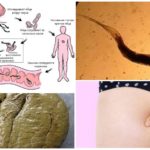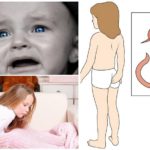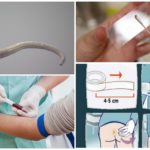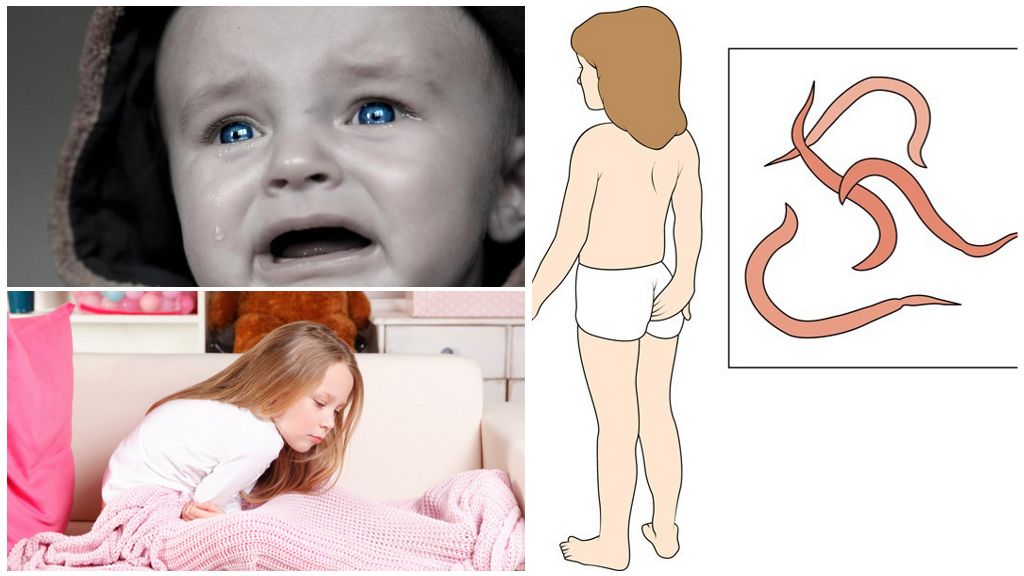What the pinworms look like in feces
Content
- Pinworm infection
- Pinworms in adults
- Pinworms in children up to a year
- Pinworms in children
- Diagnosis of enterobiasis
Enterobiasis occurs in people of any age, but most often this disease affects children up to 10-12 years old. Infection with worms occurs unnoticed, the symptoms do not always indicate the type of pathogen.With the appearance of abdominal pain, loss of appetite, weight loss, allergic rashes, people try to diagnose remotely. They are looking for images of parasites, their eggs on the human body, photos of pinworms in feces, a description of the symptoms in different sources. Such an attempt to deal with painful sensations will not lead to the desired result; it is better to consult a doctor.
Symptoms of enterobiasis
The appearance of pinworms in the body passes without any symptoms in more than half of the patients. The rest of the patients notice signs of ill health after 4 weeks from infection. By that time, the parasites ripen in the intestines and begin to lay eggs.
Common symptoms of the disease
The main symptoms of pinworms do not have any fundamental differences in children and adults. These include:
- Intense itching in the perianal region, starting at night. It is at this time that the female pinworm leaves the intestine and lays eggs.
- The appearance of scratching around the anus.
- Disturbance of appetite: it can be lowered or raised.
- Hot flashes in the abdomen.
- The painful urge to stool, the release of mucus from the feces.
- The alternation of constipation with diarrhea.
- Change the color of feces.
- The appearance in the feces of blood.
- Weight loss.
- Pallor of the skin.
- Unpleasant smell from the mouth.
- The appearance or exacerbation of skin and respiratory allergies.
- Inflammatory diseases of the female external genital organs.
- Sleep disturbance, decreased performance, irritability.
- Neurotic manifestations, decreased mood.
Nature of clinical manifestations
To understand why these or other symptoms of the disease appear, for which it is worth conducting a study of feces, how the infection proceeds, this helminthic invasion should be briefly described.
Mature pinworm eggs enter the body through the mouth. Parasites begin to descend the gastrointestinal tract. In 2-4 weeks, larvae emerge from the eggs and develop to mature individuals. Then the pinworms mate, after which the males die, and the females continue their way through the large intestine, but with feces they do not leave. The laying of worm eggs does not occur in the intestinal lumen, but in the area of the perianal folds.
On a note!
At night, female individuals crawl out of the colon and lay eggs. That is why the belief that pinworms go out with feces on their own is wrong.
The maturation of the parasite's eggs requires compliance with certain conditions: high humidity and temperature close to 36 degrees. These conditions are created in the area of the human anus.
After performing the biological task, the female pinworm dies and can be detected on the linen, skin of the child or adult, toilet paper with feces as a translucent worm up to 14 mm long.
The release of acid by helminths causes itching. This symptom is considered to be the main one when describing the enterobiosis clinic. A person can scratch the affected place and break the parasite. But in this case it will not be possible to find dead pinworms in feces.
Pinworms in adults
Adult enterobiasis often develops among people in contact with children - educators, nannies, and teachers.
Infection with pinworms is accompanied by the following symptoms:
- itching;
- appetite disturbances;
- weight loss;
- recurrent abdominal pain;
- nausea, vomiting.
- deterioration of hair and nails;
- sleep disturbance, irritability;
- decreased immunity, frequent colds;
- appearance of mucus and blood in feces.
Important!
When infected with pinworms women may be prone to inflammatory diseases of the genitourinary sphere.The delicate symptoms do not respond well to conventional treatment; condition may affect the ability to conceive.
Disruption of the intestine when infected with pinworms due to:
- with chronic allergic inflammation in the wall;
- with parasites sticking with the formation of hematomas on the mucous membrane and minor bleeding;
- violation of the composition of the bacterial flora and the deterioration of food digestion.
This state of the intestine leads to appendicitis, episodes of diarrhea, constipation, and allergic manifestations. But even at the peak of dysfunction of the digestive system, pinworms in the feces of an adult can hardly be detected. The small size of the worms, a feature of the life cycle in which only fertilized females come out are the main reasons for the ineffectiveness of self-diagnosis.
Important!
Detection of scarlet blood in feces - the basis for seeking medical attention and examination. In addition to the diagnosis of pinworms in this case, experts should exclude rectal hemorrhoids, fissures and polyps, and cancer. Black blood in the feces appears with ulcerative lesions of the stomach.
How is helminthiasis in children
The pinworm disease in childhood is very dangerous for the developing organism. Enterobiasis is associated with a careless attitude to the rules of hygiene of the child or adults caring for him.
Pinworms in babies
The greatest danger is infection with pinworms of children under one year old. The reasons are as follows:
- At this age, the protective barriers of the body are not yet sufficiently formed.
- Infants cannot describe their discomfort.
- The symptoms of a diaper under the diaper are easily confused with diaper dermatitis or allergic reactions.
- With violations of the stool in these children, dehydration increases catastrophically quickly. This condition is life threatening.
- The process of absorption in the intestine is significantly disturbed, along with feces the substances necessary for the body are released.
It should describe how infection with pinworms in children under one year.
- The child becomes capricious, falls asleep badly.
- Redness occurs in the skin of the anus, a bacterial infection develops easily under the diaper, and suppuration is possible.
- The child is lagging behind in psychomotor development.
- The baby stops gaining weight, height, possible loss of body weight.
- Outwardly, such a child looks pale, thin.
- There is a rash, not only in the anus, but also in other parts of the body.
Parents of the baby can examine the contents of the diaper to see what the pinworms look like in the feces. Separate concern cause mucus, traces of undigested milk. Some sources indicate that parasites may resemble thin white filaments in the feces. However, more often such a search is useless.
It is impossible to find eggs of parasites in the feces of children, but they will be in significant quantities in the hands of babies, under the nails, in the hair of pets, on toys, clothes and underwear, furniture.
Important!
Pinworm disease in children up to one year old and older reduces the efficacy of DTP, measles and rubella vaccines. The formation of post-vaccination immunity worsens, as a result of which antibodies against infections are not formed in the required amount.
Therefore, in cases of suspected helminthic invasion in children, tests are carried out to identify parasites: feces are tested and helminth eggs are tested. And just making sure there is no infection, make the necessary vaccinations.
When pinworms or other worms are detected, de-worming is first carried out with control of the result.
Pinworms in children of preschool and school age
The disease with pinworms is also difficult for preschool children. Toddlers are easily susceptible to the development of allergic reactions due to the immaturity of the body's barriers. Attending preschool education increases the risk of pinworm infection. At this age, children only acquire the skills of tidiness and can not immediately guess to wash their hands after using the toilet.
Parents or caregivers will notice that:
- The child constantly tries to scratch the anus. Adults or other children can pay attention to this behavior, and the baby will become an object of ridicule.
- The child becomes moody, tearful, often complains of abdominal pain.
- Even potty-trained children may develop urinary and fecal incontinence.
- The kid is gaining weight poorly, looks exhausted, emaciated.
- Perhaps the occurrence of inflammatory infiltrates with pinworms in the rectum.
- The child is hardly distracted from unpleasant feelings, plays worse with other children.
- There is a habit of biting nails, sucking fingers, combing the anus, which remains after getting rid of pinworms.
- The child complains of fatigue, headaches.
When examining feces parents can pay attention to the change in its consistency, a greenish hue, an unpleasant smell. Suspicion of helminthiasis leads to a search on the Internet for images of parasites, photos of pinworms in a child’s feces, but the information obtained will not be reliable.
Parents should be alerted:
- Detection of blood in the stool.
- The child is prone to colds.
- There are skin and respiratory allergic reactions.
- Massive carious damage to the teeth, inflammation of the gums.
Important!
Pinworm disease at the age of 5-9 years - the cause of mental retardation. Such children are poorly assimilated material, can not focus on the implementation of a particular task. Due to frequent viral and bacterial diseases, they miss kindergarten, school. Children worry about itching, become withdrawn, suspicious. Violation of adaptation in the team.
The symptoms of pinworms over the age of 11 -12 years old do not have special differences with those in adults.
At detection of blood in the feces in children should be carefully examined. It is necessary to exclude the development of tumors, cracks and injuries of the rectum fecal masses with persistent constipation.
How to detect pinworms in feces
When diagnosing helminth infections, the doctor interviews and examines the patient, will issue a referral for blood, urine, feces, and scrapes to detect eggs.
The results of a hematological study will indicate only anemia with prolonged parasitism of pinworms and eosinophilia as a result of sensitization of the organism.
Detection of worms in a person in the feces is possible in the following cases:
- when infected with another type of parasite;
- pinworms - after taking laxatives or antihelminthic drugs.
Important!
Researches of feces on the eggs of the worm are recommended for suspected infection with two types of worms at the same time.
In all other cases, for the diagnosis of enterobiosis use:
- scotch test;
- scraping on enterobiosis.
Scotch test
This diagnostic method is also called the Grathem method or tape test. This study is conducted in children. It helps to detect pinworm eggs. The technique is as follows:
- The test is performed in the morning before the child visits the toilet.
- To do this, take a piece of plastic tape and stick with a sticky side to the area of the baby's anus.
- Then the adhesive tape with the biomaterial gently glued to a glass slide.
- The sample is taken to the laboratory within the next 2 hours.
- The doctor examines the imprint under a microscope. He can notice small translucent oval-shaped eggs. Traces of feces and adult parasites are not found.
A negative result is considered when the patient complains of itching or is suspected helminthiasis, and as a result of a series of studies, pinworm eggs were not found. During periodic medical examinations, the test is taken once.
Scraping for Enterobiasis
This study for the diagnosis of enterobiasis is carried out in a clinic or laboratory. In the morning before scraping enterobiosis, it is forbidden to wash; it is better to empty the bowel after taking the material.
The health care professional will ask the patient to bend down and spread the buttocks with the hands, then hold the cotton pad covered with soda or glycerin over the perianal folds. Instead of a tampon, you can use a special spatula.
The material is placed on a glass slide and microscopically.
What will show tests for enterobiasis
Detection of pinworm eggs in humans indicates infection with enterobiasis. With a negative result, but the presence of clinical manifestations, the test is repeated up to 3 times with an interval of several days. The survey method itself does not involve the collection of feces and will not show pinworm eggs in feces.
Enterobiasis affects children more often than adults. The disease manifests itself painful itching in the anus, a decrease in immunity, disturbances in the gastrointestinal tract, weakness, decreased performance, growth and development. The definition of human pinworms in feces for the diagnosis of the disease is not carried out.
A common and effective method for detecting worms is scotch test and scraping for enterobiasis. If the doctor suspects infection with pinworms, but cannot detect them in the material, the study is repeated.















